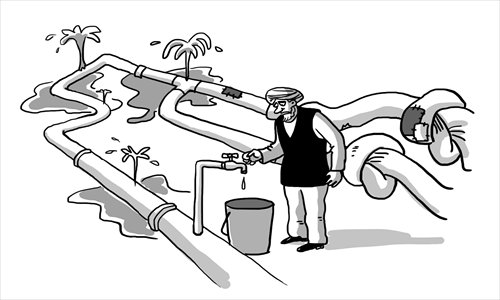Repairs could stifle South Asia’s water war

In recent weeks, militants in Pakistan have escalated their hostile rhetoric toward India. The subject of their ire is water. Hafiz Saeed, the head of militant Islamist group Jamaat-ud-Dawa, has warned that India plans "to make Pakistan barren" by preventing the waters of the Indus Basin from flowing downstream to Pakistan.
On the subcontinent and across South Asia, water is a major source of tension and a potential trigger for conflict. It is a precious resource in a region where political relations are tense and trans-boundary water agreements are fragile.
The best hope for averting water war lies not in repairing frayed political ties or enhancing water diplomacy, but rather in better managing domestic water resources.
South Asia houses a quarter of the world's population, yet contains less than 5 percent of global annual renewable water resources. Annual water availability has plummeted by nearly 70 percent since 1950. Some researchers believe South Asia could face widespread water scarcity by 2025.
This shortage is unsurprising. The region suffers from high population growth, vulnerability to climate change, arid weather, and agriculture-dependent economies.
Yet it is the interconnected water geography of South Asia that risks plunging the region into water-fueled conflict. Many countries depend on the same rivers for their water supply. India, Bangladesh, and Nepal look to the Brahmaputra, while both Pakistan and India are beholden to the rivers of the Indus Basin.
Additionally, many major rivers originate in or pass through politically contested or tense areas, such as the Tibetan Plateau and Kashmir. It is no surprise that many of South Asia's riparian pairings, such as India-Pakistan for the Indus, and India-Bangladesh for the Brahmaputra and Ganges, reflect the region's most troubled bilateral relationships.
Researchers present several water-driven nightmare scenarios. One involves militants in eastern Pakistan vowing to avenge Indian "water theft" by launching terror attacks on India. New Delhi then dispatches troops to its western flank, and threatens to shut off western river flows into Pakistan.
Another scenario involves Himalayan glacial melt leading to water scarcity in lower-riparian Bangladesh, sparking migrations of Bangladeshis into India's politically volatile Assam state, thereby feeding into Assam's long-standing xenophobic sentiment and exacerbating instability.
These hypothetical scenarios crystallize the importance of trans-boundary water arrangements. Unfortunately, such mechanisms are weak in South Asia.
The Mahakali accord, to which India and Nepal are party, has not been properly implemented. The Ganges agreement involving India and Bangladesh has been held up by several disagreements.
The Indus Waters Treaty between India and Pakistan is an exception. It is credited with having prevented the two nations from fighting wars over water.
However, new developments not envisioned when the treaty was ratified back in 1960, like climate change, are prompting many analysts to worry that the treaty will not endure.
More broadly, South Asia regional cooperation is elusive. This is seen in its lack of economic integration. The region has dreadful railways, roads, and electricity systems, and South Asia's intraregional trade is tiny relative to its international trade.
Political integration is just as poor. The region has many disputed borders, and its countries have fought several wars with each other. Mistrust and hostility are widespread, which greatly undermines the prospects for water cooperation.
So what can be done? The answer is to look within, and to muster better efforts to improve internal water governance.
This means, for example, that Pakistan need to repair the aged canals and pipes that cause millions of gallons of water to be lost to leakage every day, and build wastewater treatment facilities to improve the quality of urban surface water that sickens and kills hundreds of thousands every year.
Meanwhile, it also means that India should repair the pipes and pumping stations that cause more than a third of New Delhi's fresh water to be lost to leakage.
If South Asia successfully implements such demand-side management policies, the region would become more judicious in its use of existing resources, less threatened by the specter of scarcity, and less likely to implement destabilizing water policies.
Upper riparians would be less likely to initiate new water-generation projects that upset downstream neighbors, and lower riparians would have less incentive to stoke tensions with upstream neighbors by accusing them of water theft.
The result? The political situation would stabilize a bit, giving the region some much-needed space to establish data-sharing regimes, water-measurement technology exchanges, and other confidence-building measures that help promote water cooperation.
In other words, sounder water management inside countries can create a more favorable political climate for the pursuit and achievement of lasting external water cooperation.
The author is the South Asia associate at the Woodrow Wilson International Center for Scholars. He can be reached by email at michael.kugelman@wilsoncenter.org or Twitter @michaelkugelman.